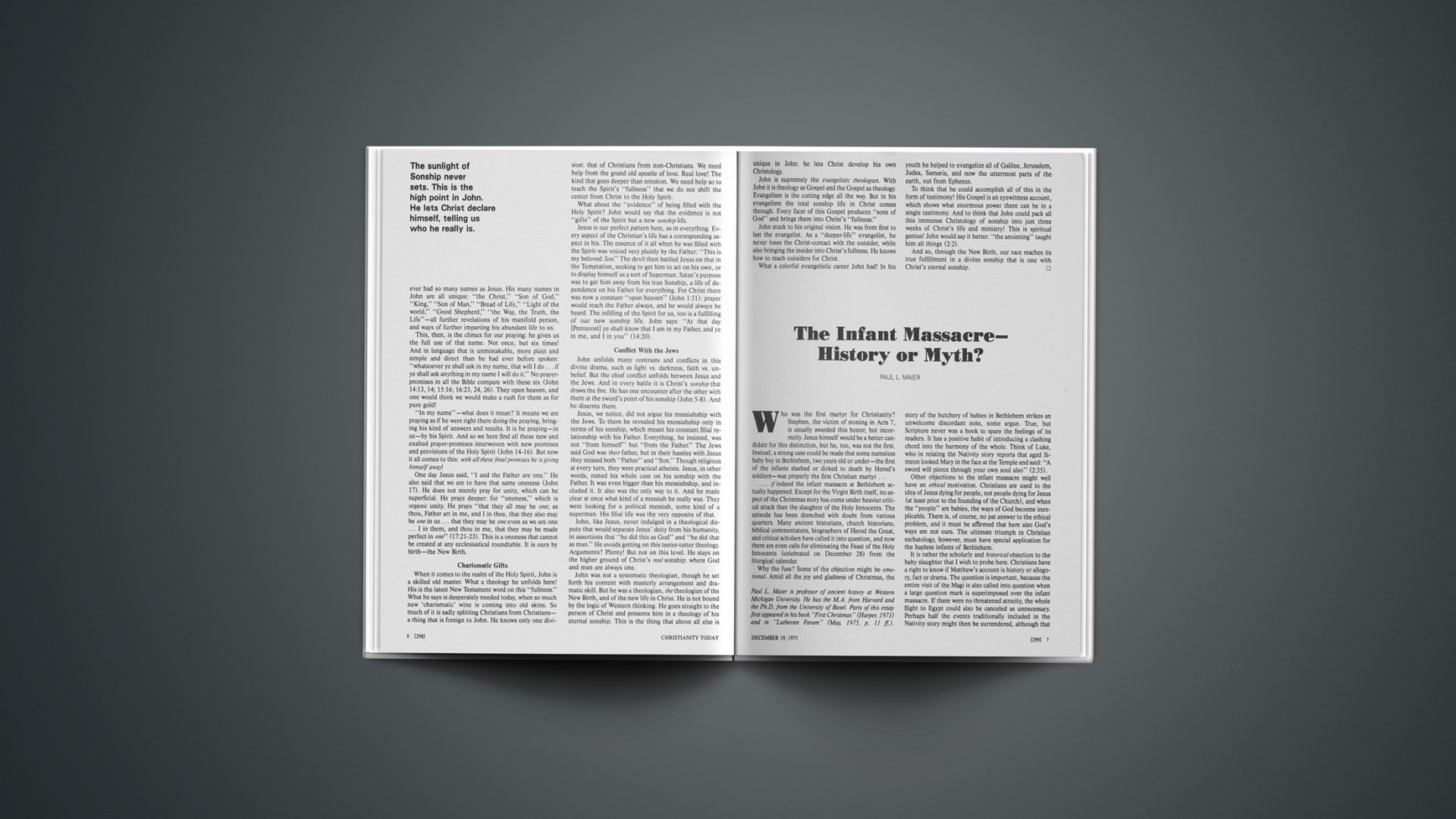Who was the first martyr for Christianity? Stephen, the victim of stoning in Acts 7, is usually awarded this honor, but incorrectly. Jesus himself would be a better candidate for this distinction, but he, too, was not the first. Instead, a strong case could be made that some nameless baby boy in Bethlehem, two years old or under—the first of the infants slashed or dirked to death by Herod’s soldiers—was properly the first Christian martyr …
… if indeed the infant massacre at Bethlehem actually happened. Except for the Virgin Birth itself, no aspect of the Christmas story has come under heavier critical attack than the slaughter of the Holy Innocents. The episode has been drenched with doubt from various quarters. Many ancient historians, church historians, biblical commentators, biographers of Herod the Great, and critical scholars have called it into question, and now there are even calls for eliminating the Feast of the Holy Innocents (celebrated on December 28) from the liturgical calendar.
Why the fuss? Some of the objection might be emotional. Amid all the joy and gladness of Christmas, the story of the butchery of babies in Bethlehem strikes an unwelcome discordant note, some argue. True, but Scripture never was a book to spare the feelings of its readers. It has a positive habit of introducing a clashing chord into the harmony of the whole. Think of Luke, who in relating the Nativity story reports that aged Simeon looked Mary in the face at the Temple and said: “A sword will pierce through your own soul also” (2:35).
Other objections to the infant massacre might well have an ethical motivation. Christians are used to the idea of Jesus dying for people, not people dying for Jesus (at least prior to the founding of the Church), and when the “people” are babies, the ways of God become inexplicable. There is, of course, no pat answer to the ethical problem, and it must be affirmed that here also God’s ways are not ours. The ultimate triumph in Christian eschatology, however, must have special application for the hapless infants of Bethlehem.
It is rather the scholarly and historical objection to the baby slaughter that I wish to probe here. Christians have a right to know if Matthew’s account is history or allegory, fact or drama. The question is important, because the entire visit of the Magi is also called into question when a large question mark is superimposed over the infant massacre. If there were no threatened atrocity, the whole flight to Egypt could also be canceled as unnecessary. Perhaps half the events traditionally included in the Nativity story might then be surrendered, although that could be carrying a “domino theory” a bit too far.
But the critical treatment accorded Matthew 2 also provides a warning to all scholars that the historical method must always be used with caution and fairness. As an ancient historian, I blush to note how often many otherwise well-meaning theologians so easily surrender sizable segments of the Gospels in a very uncritical use of Bultmann and others. They do so on a quite arbitrary basis, without beginning to exhaust all the hard data and crucial clues from antiquity.
Matthew’S Myth?
Questioning the carnage at Bethlehem is nothing new. Critical scholars have challenged the episode for several centuries. Today, three out of four recent biographies of Herod the Great deny it entirely. Only one, by Stewart Perowne, states that Herod’s ordering the slaughter “is wholly in keeping with all that we know of him” (The Life and Times of Herod the Great). The other three dismiss the episode as “legend” (A. H. M. Jones, The Herods of Judaea) and offer such comments as this: “The tale is not history, but myth or folk-lore … The story is invented” (Michael Grant, Herod the Great). The worthy Jewish scholar Samuel Sandmel concurs, calling Herod “maligned” by Matthew’s Gospel. “None of these motifs is historical,” he claims; “they are simply extensions of the animosity which the ancients felt for Herod” (Herod—Profile of a Tyrant).
Such statements, frankly, are a cavalier misuse of the historical method by three otherwise extremely reputable scholars. So elementary an item as documentation seems to have been beyond Jones in this instance, since he nowhere supports with any source notes what must finally be only his opinions regarding the “legend” of the massacre. Grant, similarly, offers as evidence only a very tenuous argument from analogy, discussed below. And Sandmel’s one and only documentation is no better than an argument from silence: “Not a word of this is in Josephus.” (In a delightful contradiction, however, all three volumes are studded with art works dealing with the infant massacre!)
These are extremely slender supports for the flat declarations by all three authors that the massacre is legend, or is not historical. A more careful historian would at least have conditioned such a claim with “probably,” or have styled Matthew’s account “questionable,” rather than denying it outright. What seems to have happened is critical tradition-building. Some time ago, it became high scholarly fashion in secular circles to doubt the infant massacre, and soon many biblical scholars followed suit. Both groups cheerfully assumed opinion to be fact and did not bother to make a careful historical search of the probabilities of Matthew’s claims. They operated from a series of false premises that I hope to expose.
Those who doubt or deny Matthew’s account generally do so for one or more of the following three reasons:
1. The silence of Josephus. Unquestionably, the first-century Jewish historian is the prime source for any information on Herod the Great, and he does not mention any baby slaughter in Bethlehem. But this strongest argument that can be marshalled against the historicity of the infant massacre is the weakest form of evidence in use: the argument from silence.
If Josephus had known about the atrocity, he would have written about it, so the argument runs. One obvious reply is that Josephus may indeed not have known about it, whereas Matthew did. From many considerations, this seems indeed to have been the case. But even if Josephus had heard about it, he would not necessarily have referred to it in his life of Herod. Why not? Because he had such a withering—and wearying—variety of horrendous things to report about Herod throughout his last years and months that this item might not have ranked high enough for inclusion.
What? Not report the ghastly slaughter of “hundreds of Jewish boys,” as one recent commentator put it? Wrong premise! According to best scholarly estimates, the actual number of victims probably lay between twenty and twenty-five, if that many. Too many have been misled by bad translations of Matthew’s phrase that the holocaust was “in Bethlehem and in all the coasts thereof” (KJV), that region (RSV), its surrounding district (Jerusalem), and its neighbourhood” (NEB and TEV). The last version is the best, because the Greek at Matthew 2:16 is horiois, which means “its borders” or “boundaries.” Today we would say “Bethlehem and its suburbs,” except that Bethlehem was too small to have suburbs in those days. Anything more than a mile or two from town would have fallen immediately under the horiois or borders of Jerusalem a scant five miles away, not Bethlehem.
Any word studies on how Matthew uses horos later in his Gospel for wider districts and regions are futile, because the term itself is just as elastic as the term “boundaries” is in English. There are boundaries of a hamlet and boundaries of a nation. A figure larger than a dozen or two victims cannot be supported even if a larger region were allowed for Matthew’s horiois. The hilly Judean badlands around Bethlehem are extremely arid and forbidding, and most of that desert territory is uninhabited to this day. The area immediately east of the town is afflicted with intense daytime heat.
Best demographic and actuarial estimates, on the basis of a small town of perhaps 2,000 inhabitants, would be three or four dozen children two years old and under, only half of whom would be boys. The human imagination, of course, enlarges not only the beautiful but also the atrocious. So Hollywood’s version in films on Jesus show Herod’s troops going from house to house, slashing swords through babies who, mirabile dictu, are present two and three babies strong in every house, on both sides of the street! Not even “Fertile Acres” or otherwise-named young-married housing on pre-Pill college campuses could boast rabbit-warren statistics like that!
Quite probably Josephus never even heard of so local an event. Born almost a half century later, he had far more grisly things to report concerning the close of Herod’s tortured career. In one of his lucid moments, the aging king was worried that no one would mourn his death—a likely possibility, to say the least! So he issued orders from his deathbed that leaders from all parts of the country were to be locked inside the great hippodrome at Jericho. The moment he died, archers were to massacre these thousands in cold blood, so that there would indeed be universal mourning associated with his death.
Now weigh such a datum—threatened death to “all the principal men of the entire Jewish nation” [Antiquities xvii, 6, 5]—with the loss of a dozen or so babies in overlooked Bethlehem. Which do you include in your history as you are trying to wind up Herod’s rotting life, provided (as seems unlikely) you had even heard of the Bethlehem episode? Moreover, Josephus wrote for a Greco-Roman audience, which would have had little concern with infant deaths. The Roman father had the right not to lift his baby off the floor after birth, letting it die, while Greeks regularly practiced infanticide as a kind of birth control, particularly in Sparta.
Does the silence of Josephus, then, mean anything in this connection?
2. A “construction” to “fulfill” prophecy. Matthew’s motivation in reporting such a tale, it is argued, is to make an honest prophet of Hosea by helping “fulfill” his prediction: “Out of Egypt I called my son” (11:1). Matthew had to have a good reason to place Jesus in Egypt to get him out again, in this scenario.
But this is extremely arbitrary reasoning, which in essence proves absolutely nothing. If Matthew were merely scheming to “fulfill” an Old Testament prophecy, he could have chosen other prophecies far more easily demonstrable. For this one he had to construct a whole Rube Goldberg-type scenario involving magi from the east, a star, the confrontation with Herod, murdered babies, a trip to Egypt, and the like—all to “fulfill” a line from Scripture. This reasoning makes of Matthew little more than a rabid novelist with one of the wildest imaginations in the ancient world. Isn’t it more likely that he chose a quotation from the Old Testament that corresponded to events that actually happened to the infant Jesus?
3. The argument from analogy. The premise here seems to be that no atrocity can happen twice: if a similar episode is claimed, the later account must have been copied from previous reports. So Grant writes that the infant massacre “offers analogies with the Midrash of Moses’ rescue from the slaughter of Hebrew children in Egypt, and is paralleled by similar stories referring to the births of Augustus and Nero.”
But a check on those stories shows remarkable differences from the Bethlehem massacre. And even if they were congruent, would this prove anything? History and biography repeat themselves with a monotony even in their surprising twists. Take the childhood stories of great men, for example: nearly all of them seem to have almost died of some dire infant illness, did they not? And why did the father of almost every great man—ranging from Martin Luther to Karl Marx—want his son to become a lawyer rather than what he eventually became?
Throughout history, all suspicious men in power have had a nearly paranoid fear of slipping from that power. There are so many documented reports of rulers behaving almost exactly as Herod did that, far from disproving Herod’s conduct because of analogy, they rather tend to confirm it. In Herod’s own life, according to Josephus, we have an example of what he could do to any younger rivals for his post: he merely put them to death, as he did three of his own sons! Why go back to Moses, or Cyrus, or anywhere else for parallels when Herod himself had gone the route of killing possible threats to the throne before?
So, I would plead, whenever historical method is employed: let the arguments be solid rather than arbitrary; let them actually prove something, rather than providing interesting speculations that are really remarkably unconvincing when compared with the hard data that do survive from the ancient world.
Matthew’S History
A better use of historical method is to compare the details of the Matthew account with the copious extrabiblical evidence. Is there any real conflict, any genuine clash when Matthew’s account is superimposed on the panorama of the Palestinian past as we know it so well from Josephus, Philo, the rabbinical traditions, and archaeology? As I demonstrate in my First Christmas, there is surprisingly little, if any.
Matthew blends even better into Josephus than into his co-evangelist, Luke, who reports the Holy Family as returning from Bethlehem to Nazareth, not Egypt (although I’ve never found that as difficult to harmonize as some would have it). Both Matthew and Josephus—again, the prime source for Herod—show the king in his advanced years as a scheming, suspicious, unpredictable, violent, hypocritical, brooding wreck of a man. First read Josephus’s portrait of Herod in his last years (Antiquities xvi and xvii). Then read Matthew 2. You will be overwhelmed by the identical personality profiles that emerge of Herod, once rightly styled “the Great.”
Compute the infant massacre at Bethlehem into all these data and it “programs” nicely. Such a crime was very much in character for Herod in his last months, when illness and court intrigue had nearly deranged the man. His ten wives had borne a wriggling, ambitious brood of sons who turned the palace into a human can of worms in their scheming to succeed him.
Herod was so jealous of his favorite wife, Mariamne, that on two occasions he ordered that she be killed if he failed to return from a critical mission. And then he finally killed her anyway, as well as her grandfather, her mother, and his brother-in-law, not to mention numerous subjects. During a swimming party at Jericho he also drowned the high priest, who happened to be another of his brothers-in-law.
His last months were even worse. He spent most of his days sniffing out plots against the throne. Racked in the body with cancer and gonorrhea, and in the mind with advancing paranoia, he was continually writing Rome for permission to execute several of his sons for treason. He finally killed three of them, as cited earlier. Finally, even his patron and friend Augustus had to admit: “I’d rather be Herod’s pig than his son.” It was both a play on the similar-sounding Greek words for son and pig, and a wry reference to the fact that pork was not consumed by Jews.
Is this the sort of person who could have ordered the elimination of a couple dozen babies in Bethlehem? Unquestionably. As it was, Bethlehem lay just northwest of his fortress-palace called the Herodium, a large, breast-shaped mountain where he was arranging his own tomb. Here least of all could he tolerate sedition in the name of any infant “king of the Jews.” And no magi would turn him into a lame duck!
But of Herod’s final plans two miscarried. The Jewish leaders jammed inside the Jericho hippodrome were not slaughtered but released after his death was announced. And the baby who was supposed to die in the Bethlehem massacre was instead jogging along in the arms of his mother on a donkey-back ride to Egypt.
Matthew’s novel? Or Matthew’s history? All evidence supports the latter.










